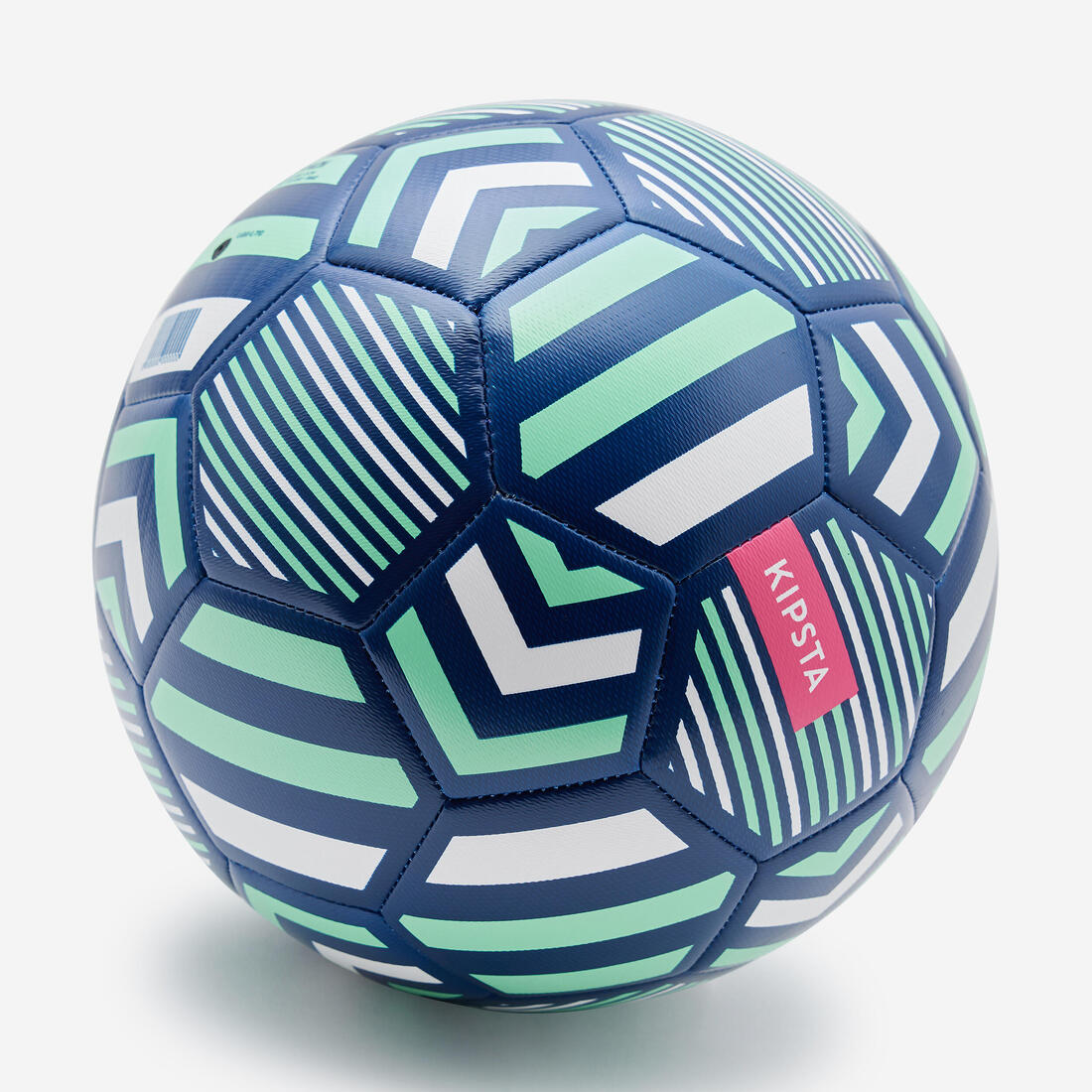Σχεδιάσαμε αυτήν την Μπάλα Εκμάθησης ειδικά για παιδιά. Είναι πιο ελαφρύ από ένα παραδοσιακό ποδόσφαιρο, διευκολύνοντας τα παιδιά να μάθουν να παίζουν.
Η ιστορία πίσω από αυτή την μπάλα
Μετά από πολλαπλές παρατηρήσεις για μεγάλο χρονικό διάστημα, η ομάδα μας σχεδίασε αυτήν την ελαφρύτερη μπάλα διατηρώντας όλα τα τεχνικά χαρακτηριστικά ενός παραδοσιακού ποδοσφαίρου. Η ουροδόχος κύστη (2 km νήματος τυλίγεται γύρω από την κύστη) εξασφαλίζει ισχυρό φούσκωμα και καλύτερη σφαιρικότητα .
Πιο ελαφρύ από μια κανονική μπάλα
Αυτή η μπάλα θεωρείται ελαφριά επειδή είναι περίπου 15% ελαφρύτερη από ένα ποδόσφαιρο κανονικού μεγέθους 5. Τι διαφορά έχει αυτό; Χάρη στο βάρος του, οι νεαροί ποδοσφαιριστές μπορούν να κλωτσήσουν ή να κεφαλιάσουν την μπάλα πιο άνετα. Είναι επίσης πιο εύκολο να στοχεύεις, να κάνεις μακριές πάσες και να σκοράρεις γκολ. Εγγυημένο χτύπημα!
Πολύ ελαφρύ? Πολύ βαρύ? Το βάρος είναι τυποποιημένο...
Το βάρος αυτής της μπάλας είναι μεταξύ 340 g και 360 g σε σύγκριση με 410 g και 450 g για ένα παραδοσιακό ποδόσφαιρο μεγέθους 5.
Ποσο μεγαλο ειναι? Ποια είναι η περιφέρεια;
Το μέγεθος αυτής της μπάλας είναι μεταξύ 68,0 cm και 70,0 cm (μέγεθος 5).
Μια ""στρογγυλή" μπάλα;
Μετράμε τη σφαιρικότητα του ποδοσφαίρου σε 4500 διαφορετικά σημεία και στη συνέχεια εξετάζουμε τυχόν διαφορές. Εάν η απόκλιση είναι μεγαλύτερη από 1,8% (FIFA PRO Standard), οι μηχανικοί μας είναι επιφορτισμένοι με τη βελτίωση της σφαιρικότητας για να εξασφαλίσουν μια σταθερή αναπήδηση.
Δοκιμή μέγιστης απώλειας πίεσης: ορίστε τι κάνουμε...
Φουσκώνουμε την μπάλα στην προτεινόμενη πίεση (δηλαδή 0,8 bar).72 ώρες αργότερα, η μπάλα δεν πρέπει να χάσει περισσότερο από το 15% της πίεσής της, δηλαδή περίπου. 0,1 bar. Επομένως, η πίεση μετά από 72 ώρες πρέπει να είναι περίπου. 0,7 bar. Αυτό σημαίνει επίσης ότι είναι φυσιολογικό μια μπάλα να χάνει πίεση μετά από μερικές ημέρες.
Έχουμε επίσης δοκιμάσει πόσο νερό απορροφά η μπάλα...
Προσομοιώνουμε τις βροχερές συνθήκες παιχνιδιού σε ένα εργαστήριο, αφήνοντας την μπάλα να καθίσει σε 2 cm νερού σε ένα περιστρεφόμενο στήριγμα ενώ την υποβάλλουμε σε 250 συμπιέσεις. Μέχρι το τέλος της δοκιμής, αυτή η μπάλα δεν πρέπει να έχει απορροφήσει περισσότερο από το 15% του βάρους της , ή περίπου. 50 g για το μέγεθος 5.
Είναι όλα σχετικά με την αναπήδηση
Μεταξύ 125 και 155 cm με μέγιστη διαφορά 10 cm μεταξύ της υψηλότερης και της χαμηλότερης αναπήδησης της μπάλας. Κάθε μπάλα πέφτει 10 φορές σε μια ατσάλινη πλάκα από 2 μέτρα ύψος.
Ούτε μια γρατζουνιά!
Η πιο απαιτητική δοκιμή στην οποία υποβάλλεται αυτή η μπάλα είναι η δοκιμή μηχανικής βολής. Η μπάλα πρέπει να αντέχει έως και 2500 βολές σε μια κεκλιμένη επίπεδη πλάκα σκυροδέματος με ταχύτητα 50 km/h σε απόσταση 2,5 m. Στο τέλος της δοκιμής, ελέγξτε:- τη γενική κατάσταση της μπάλας: η ραφή πρέπει να αντέχει σε αυτή τη δοκιμή.- η περιφέρεια: δεν πρέπει να έχει αυξηθεί περισσότερο από 1,5 cm.- η σφαιρικότητα: δεν πρέπει να έχει μεταβληθεί περισσότερο από 1,8%.- η πίεση: απώλεια η πίεση δεν πρέπει να υπερβαίνει το 12,5%.
Εσυ ΠΩΣ ΕΙΣΑΙ? Τι νομίζετε;
Εκτιμούμε τα σχόλιά σας και τα χρησιμοποιούμε για να βελτιώνουμε συνεχώς τα προϊόντα μας. Σας ευχαριστούμε εκ των προτέρων που μοιραστήκατε τα σχόλιά σας μαζί μας.
Το να μάθεις να κλωτσάς μια μπάλα και να τη βγάζεις από το έδαφος δεν είναι τόσο εύκολο όσο φαίνεται. Γι' αυτό δημιουργήσαμε αυτή τη μπάλα που είναι 15% πιο ελαφριά από τις παραδοσιακές μπάλες.
Αντοχή
Εξωτερικό στρώμα TPU για αντοχή στη φθορά.
Διαρκής κατακράτηση αέρα
Βελτιστοποιημένη κύστη για καλή κατακράτηση αέρα.
Μειωμένη επίδραση
Ελαφρύτερη μπάλα με πάνελ με επένδυση από αφρό για πιο άνετο παιχνίδι.
Πήδημα
Η μπάλα ανταποκρίνεται στα διεθνή ποδοσφαιρικά πρότυπα όσον αφορά την αναπήδηση.
Σχεδιάσαμε αυτήν την Μπάλα Εκμάθησης ειδικά για παιδιά. Είναι πιο ελαφρύ από ένα παραδοσιακό ποδόσφαιρο που διευκολύνει τα παιδιά να μάθουν να παίζουν.















































